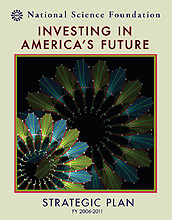News Release 06-140
NSF Announces Goals, Priorities for Next Five Years
October 2, 2006
This material is available primarily for archival purposes. Telephone numbers or other contact information may be out of date; please see current contact information at media contacts.
The National Science Foundation today released its strategic plan to guide the agency's priorities and investments for the next five years.
The plan, titled Investing in America's Future, reflects months of discussion with the research and education community and others. It is the first to be published under NSF's current leaders, and will influence the agency's FY 2008 budget request.
"Strategic planning is important for every federal agency, because it helps ensure that public funds are well spent," said NSF Deputy Director Kathie L. Olsen. "Taxpayers can be confident that we have thought carefully about giving them their money's worth. This strategic plan keeps us focused on specific goals and outcomes for the next five years.
The new plan identifies four (outcome-based) goals: discovery, learning, research infrastructure and stewardship. Each is linked to specific investment priorities, and emphasizes actual results, or outcomes. All four goals are important, but one of them--stewardship--underpins the others.
"NSF resources belong to the public, and to the research and education community," said Olsen. "In order to be good stewards, we need strong partners and collaborators, the broadest possible participation, and highly qualified staff and reviewers. This strategic plan strongly commits to those goals."
Broad participation was also emphasized during the creation of the plan itself. NSF received hundreds of comments from colleges, universities, professional societies and members of the public during the plan's development. NSF also integrated input from its advisory committees, the National Science Board and NSF staff.
NSF has developed long-range plans for many years, but started developing formal "strategic plans" after the passage of the Government Performance and Results Act of 1993. NSF's previous strategic plan was published in 2003.
In releasing the plan, NSF Director Arden L. Bement, Jr., emphasized NSF's role in long-term competitive strength. "The strategies we will follow...demonstrate NSF's continued leadership, in keeping with the President's American Competitiveness Initiative, in shaping the science and engineering landscape into the future," he said.
-NSF-
Media Contacts
Mary E. Hanson, NSF, (703) 292-7738, email: mhanson@nsf.gov
Program Contacts
Craig R. Robinson, NSF, (703) 292-4292, email: crobinso@nsf.gov
Related Websites
Investing in America's Future: http://www.nsf.gov/pubs/2006/nsf0648/nsf0648.jsp
The U.S. National Science Foundation propels the nation forward by advancing fundamental research in all fields of science and engineering. NSF supports research and people by providing facilities, instruments and funding to support their ingenuity and sustain the U.S. as a global leader in research and innovation. With a fiscal year 2023 budget of $9.5 billion, NSF funds reach all 50 states through grants to nearly 2,000 colleges, universities and institutions. Each year, NSF receives more than 40,000 competitive proposals and makes about 11,000 new awards. Those awards include support for cooperative research with industry, Arctic and Antarctic research and operations, and U.S. participation in international scientific efforts.
Connect with us online
NSF website: nsf.gov
NSF News: nsf.gov/news
For News Media: nsf.gov/news/newsroom
Statistics: nsf.gov/statistics/
Awards database: nsf.gov/awardsearch/
Follow us on social
Twitter: twitter.com/NSF
Facebook: facebook.com/US.NSF
Instagram: instagram.com/nsfgov



